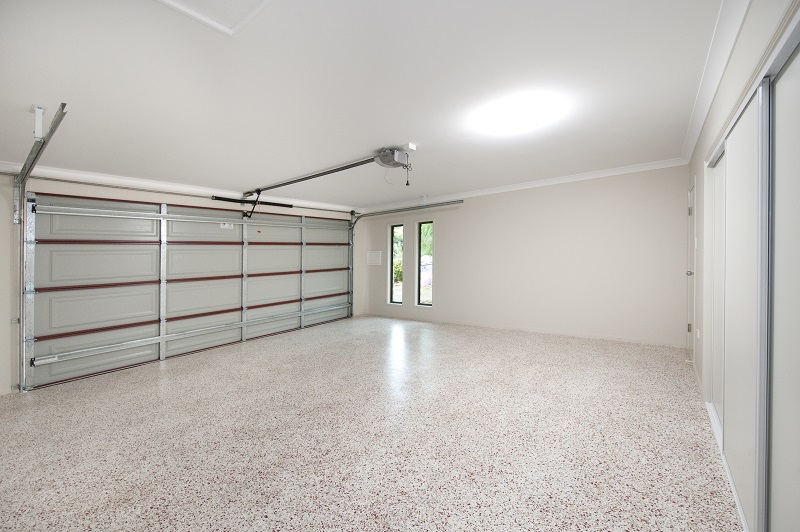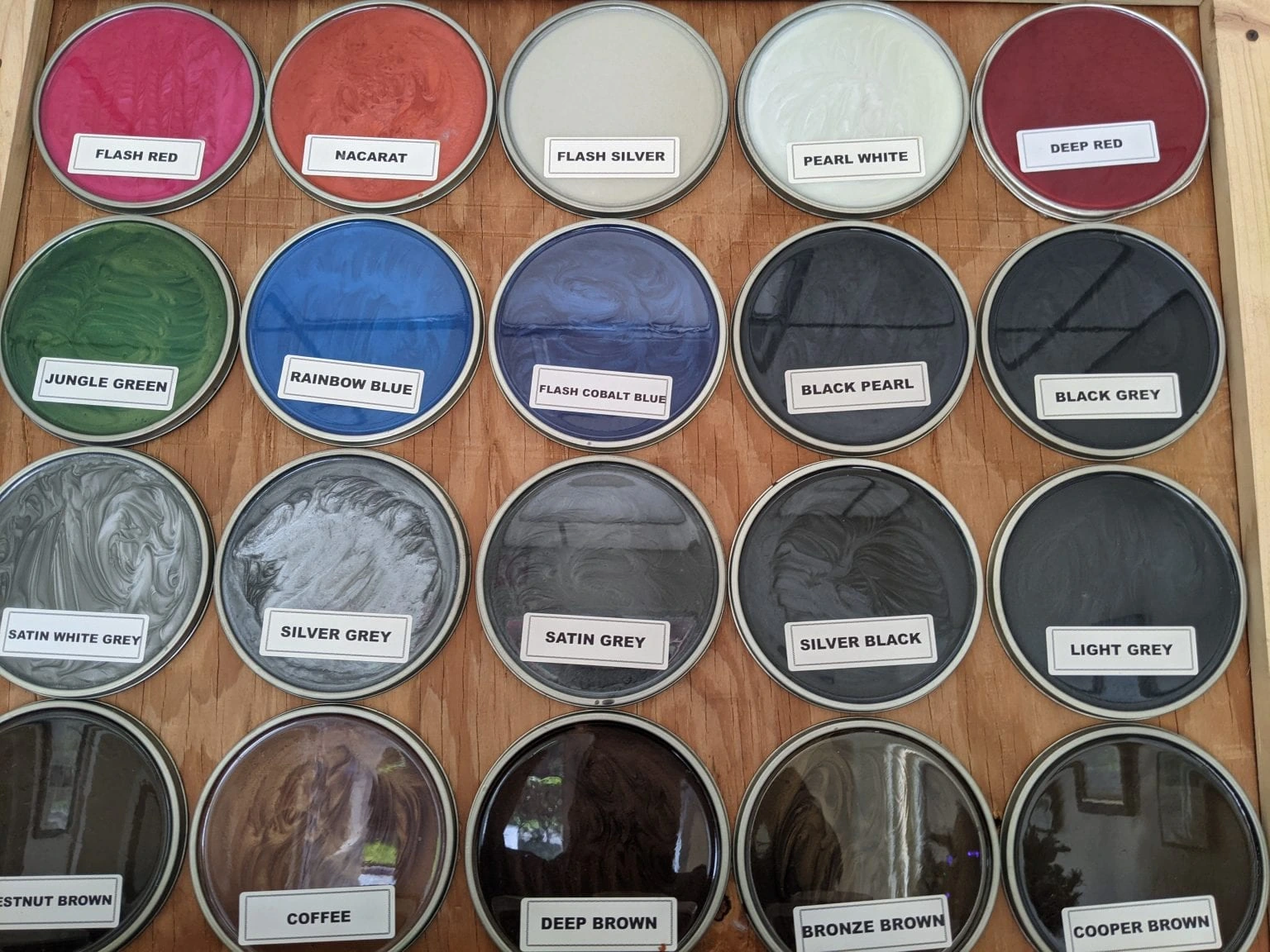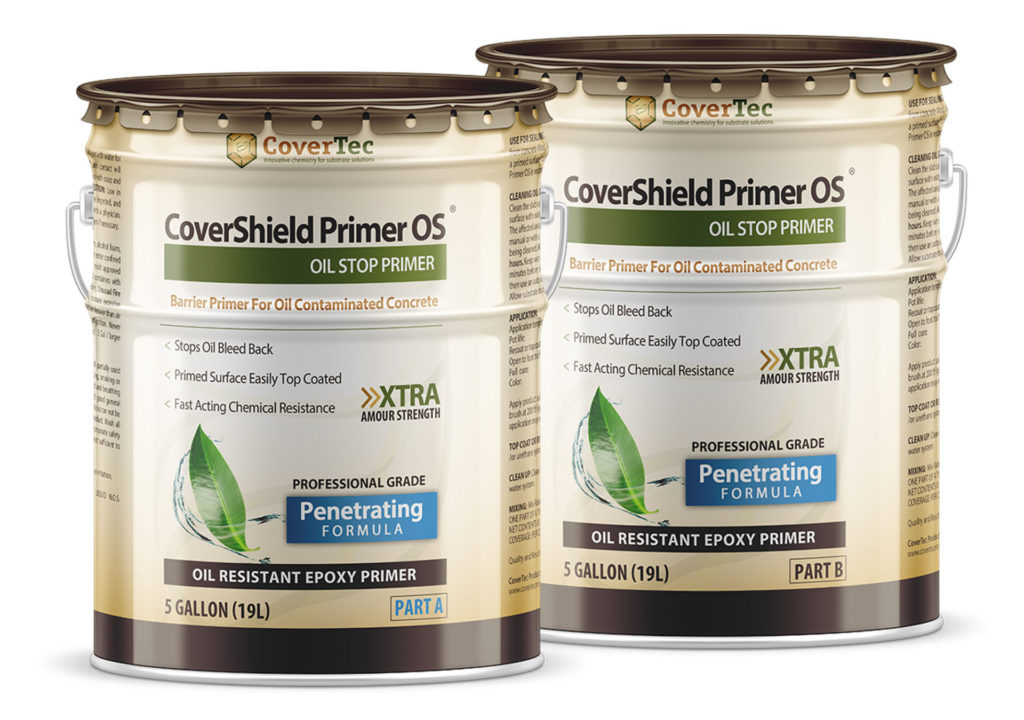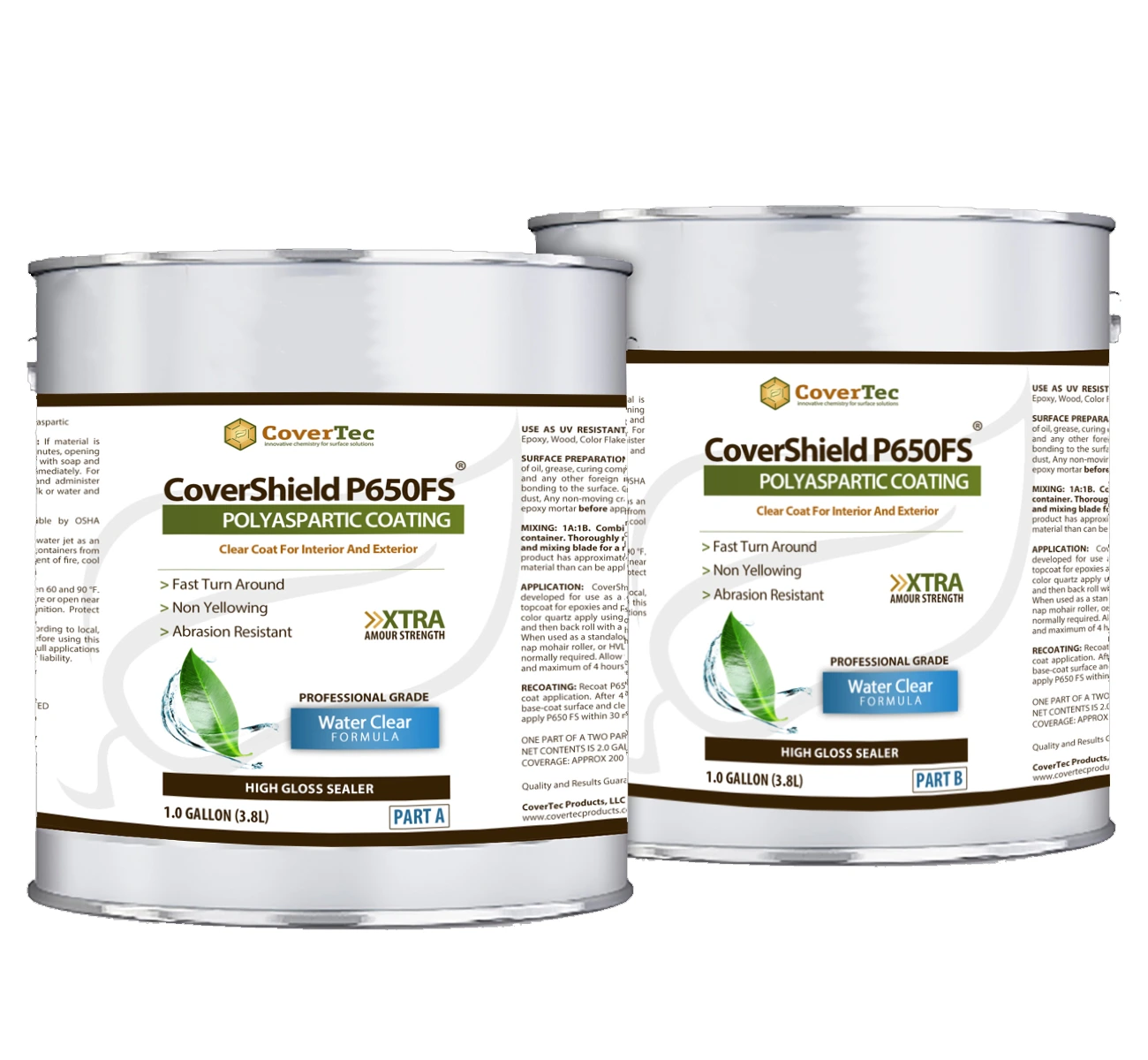If you want to protect your interior concrete floor from chemical attack or heavy-duty wear and tear, but also want to add in color or beautify the surface, you can use Epoxies.
We have our CoverShield E900. This is a 100% solids, heavy-duty epoxy.
We have a water-based epoxy. It’s the E400 WB.
Both of these products are available in standard colors and a clear coat.
We have flakes you can broadcast into these epoxies. We also have a metallic color-pigments that can be mixed into the clear E900 product.
As a topcoat, we have a P650. This is a Polyaspartic. It’s a very fast drying, UV-stable, hard-wearing, clear topcoat. You can also use it as a base coat - if you want a fast turn-around, same day service.
Showing all 7 results
-
CoverShield E400 WB Low odor, water-based, epoxy coating
$14.00 – $298.65 -
Sale
CoverShield P650 FS – Polyaspartic Floor Coating For Concrete
$14.00 – $1,055.00 -
StrongSeal Plus Gloss Heavy Duty WB Polyurethane Coating
$14.00 – $490.40 -
Vinyl Flakes 40 lb Box
$186.50
The Best Concrete Top Coats for a Durable and Attractive Finish
If you’re looking for a strong, appealing and low-maintenance finish for your concrete surface, look no further. Concrete top coats offer the best of both worlds for any outdoor or indoor space; durability and attractiveness. And with the number of available coating and sealant products on the market, it can be overwhelming to know which ones to choose. We’ve got you covered. In this blog post, we’ll outline the best concrete top coats for a durable and attractive finish so you can be sure your concrete won’t crack, chip, or peel off. Let’s get started!

Quick Insight into Key Points
Concrete top coats can offer chemical, stain and wear resistance, so it is important to choose a top coat that has good adhesion,easy to apply and durable. Popular options include epoxy sealers, polyurethane sealers, acrylic sealers and polyaspartic coatings.
What is a Concrete Top Coat?
A concrete top coat is a layer of protection or finish applied to the top surface of a slab of concrete. These coats are often used as an additional measure to protect and enhance the strength and appearance of the concrete, particularly in outdoor applications. Top coats also can provide resistance against mold and mildew, salts, oils, and gas stains that can accumulate over time.
Some of the most common topcoats are made of either acrylic or polyurethane. Acrylic top coats are designed for exterior or interior use. They have good UV resistance and are relatively easy to apply by low pressure spray, roller or flat mop. When formulated correctly they are reasonable protection from weathering elements like rain, snow, sun, and saltwater. Polyurethane top coats are longer lasting, more durable and water-resistant than acrylic top coats but they require more effort to properly apply.
Some debate exists over whether concrete hardeners or densifiers should be used in combination with a concrete topcoat. Some professionals argue that using both products create double protection that increases adhesion and helps can keep out more moisture and efflorescence on treated surfaces. Others feel that using two separate layers is redundant and ultimately leads to a less attractive finish. Ultimately, it is up to individual preference when deciding which product will work best for any given job.
The next section is dedicated to exploring different types of concrete top coats and their potential uses in various applications.
Some Useful Details:
- The application of a concrete top coat can help to extend the life of a concrete surface by up to four times as much, according to research.
- Applying a concrete top coat can help protect the concrete from the harsh effects of ultraviolet rays and extreme weather conditions.
- Using a concrete top coat can improve the aesthetic look of a driveway or patio due to its ability to give a glossy and unified finish.
Different Types of Concrete Top Coats
When it comes to protecting and preserving concrete surfaces, there are a variety of concrete top coats available, each with its own set of advantages and disadvantages. The most popular types of concrete top coats are epoxy, polyurethane, urethane, and acrylic. More recently polyaspartic chemistry has been introduced to the market
Epoxy coatings are two-part compounds that mix together to form a thick, hard-to-remove coating over concrete. This type of top coat provides superior protection against staining, fading and wear in high traffic areas such as warehouses and garages. It creates a glossy finish that is highly durable and easily cleaned. But one downside is that it requires more surface preparation than many other options and can be difficult to repair over time.
Polyurethane coatings are impact resistant, long-lasting and provide excellent protection from chemicals and solvents. They are available in a glossy, semi-gloss and matte finishes. Polyurethane offers lasting protection while providing flexibility when applied correctly. They have an extra strong bond which allows them to handle routine wear and tear with ease while maintaining their finish. However, they may require multiple layers to protect against severe weather conditions or heavy traffic wear and tear.
Polyaspartic sealers are fast curing and have good UV resistance(non-yellowing) They can be used interior or exterior. Their fast-drying time makes them a good choice for those who need quick results without sacrificing longevity. They may can require the use of solvents in order to be applied properly, thus making them a higher VOC (higher odor) solution overall.
Acrylic sealers are some of the more affordable options available on the market today. Usually they are quick drying 1 part products that don’t require any special mixing or separate catalysts. Hence they are easy to apply effectively and they dry quickly. They are also UV resistant and can be used for outside or inside applications. Although Acrylics are known as the quickest drying option on the market, their durability doesn’t stand up to harsher climates or chemical spills in comparison with other topcoat options.

No matter which type of concrete top coat is chosen for an application, proper preparation prior to installation will ensure maximum protection against wear and tear over time. Although there are several different types of concrete top coats each with their own unique characteristics and performance profiles, understanding how each type functions can help ensure that the right product is selected for any job.
The next section will explore Acrylic Sealers - another popular type of concrete top coat - in more detail to understand its attributes compared to other options on the market today.
Acrylic Sealer
Acrylic sealers are the most common type of concrete top coat, offering a wide range of attractive surfaces. They are available in both water-based and solvent-based formulas, with the latter being more resistant to UV exposure and chemical spills. Acrylic sealers produce a thin film that is breathable and resistant to abrasion. They are easy to apply evenly, often requiring several thin coats by spray, roller or brush to achieve an even coverage. Acrylic sealers generally have shorter life spans than other types of sealers, typically lasting between 1 and 2 years before requiring another application.
Another major consideration when it comes to acrylic sealers is their environmental impact. The solvents used in solvent-based acrylic sealers are toxic, meaning special care needs to be taken to ensure safe application and disposal, both for the safety of your family and the environment.
Water based sealers are rapidly replacing the older solvent based acrylic technology.
Overall, acrylic sealers offer an effective and relatively inexpensive way to protect your concrete from water damage while providing a colorful finish. However, their relatively short life span and potential toxicity may require careful consideration before deciding whether they are right for you.
Next up is epoxy sealer; this material offers many advantages over acrylic sealers in terms of durability, smoothness, chemical resistance and life expectancy. Read on to discover more about this hardwearing alternative concrete coating solution.
Most Important Points
Acrylic sealers are a common type of concrete top coat, offering breathability and abrasion resistance. They are available in water-based and solvent-based formulas. However, they can be challenging to apply evenly, have a shorter life span than other sealers, and are potentially toxic when using the solvent-based formula. Epoxy sealer is an alternative solution that presents many advantages in terms of durability, chemical resistance and lifespan.
Epoxy Sealer
Epoxy sealers are a popular concrete topcoat with many benefits. An epoxy sealer provides an attractive and durable finish that is resistant to staining, fading, moisture penetration, and scuffing. It is also highly resistant to oil and other chemicals commonly used in garages or industrial buildings.
When considering the application of an epoxy sealer, it’s important to note that it requires a higher level of preparation than other concrete top coatings as it requires careful cleaning and often grinding the surface or acid etching. Epoxy sealers provide excellent adhesion as long as they are applied to properly prepared surfaces. In addition it is important not to apply them too thin ( less than 6 mils) or they will peel off or crack with time.
Some disadvantages come with the application of epoxy sealers including long drying times, the need for special equipment for two-part mixtures, and short pot life ( working time) . Additionally, since epoxies dry with a smooth finish, spills need to be cleaned up quickly or you need to adding in a slip resistant aggregate.
As with any concrete top coating decision, it’s important to weigh all of your options before committing to a product. With the right preparation and care taking steps, using an epoxy sealer could provide you with excellent results that are low maintenance and highly durable.
The next section takes a closer look at some of the key benefits of applying a concrete top coat.
Benefits of Applying a Concrete Top Coat
Applying a concrete top coat has many benefits. It is an effective and affordable way to protect, enhance and customize the look of a concrete surface. Top coats can improve the longevity of the concrete, reduce wear and tear, increase its water resistance, decrease maintenance and give it an attractive polished finish.
On one hand, glossy finishes increase the protection level of a concrete surface since it makes the area more waterproof. In addition, having a coat over a concrete surface can help maintain its appearance for longer periods of time because dirt and other particles are less likely to seep in. Furthermore, applying a top coat can make concrete surfaces resistant to fading due to UV light exposure or other environmental changes.
On the other hand, some people feel that applying a coat takes away from the natural beauty of a concrete surface. It is possible that too much sealer can create an unnatural yellow tint to certain types of concrete. Some specialize coatings may also contain acids that can be harmful and cause damage when used on certain kinds of surfaces. Therefore it is important to consider the material and chemical composition of any coating product before using it to avoid any potential damage.
In conclusion, there are many advantages to adding a top coat on concrete surfaces. Despite these positives, some users may choose not to use top coats in order justify preserving the original look and color of the concrete. But whatever choice you make, applying a layer of protection can prevent future issues with your floor such as stains or creaks and spalls caused by moisture and freeze thaw attack. Now let's move on to examining how increased durability is another primary benefit of applying a top coat on your concrete flooring.
Increased Durability
When selecting a concrete top coat, the ability of the material to increase durability should be highly considered. Durability is essential for long-term success in areas such as driveways, walkways, and patios. When looking for surfaces that are exposed to water and dirt, one needs a top coat that will increase resistance to weather and wear and tear.
A polyaspartic urethane coating, for example, is known for being extremely resilient in different temperatures and environments. It is also highly resistant to abrasion and can extend the life of an outside area for up to 5 times longer than sealed concrete alone. Moreover, polyurethanes create a thin film on the surface, which allows easy cleaning and reduces staining.
Some argue that more traditional materials such as epoxy coatings may not be as durable as other concrete top coats. Epoxy can break down over time due to exposure to UV light – however this can be managed with good maintenance practices such as regular re-coating. And while epoxy isn't impervious to exterior elements, it still offers fairly decent durability overall when applied correctly. Ultimately it's best to weigh up the specific characteristics of each type of coating against your unique needs before making a decision on which product you will use.
The next section discusses the importance of protection for concrete surfaces. Proper protection safeguards any surfaces from staining or damages caused by UV radiation, chemicals or abrasive particles in the atmosphere.
Protection
When it comes to concrete top coats, protection is paramount and a key factor in the selection process. Not only do these coatings need to protect the integrity of the underlying concrete slab, but they must also offer additional benefits such as a durable finish and enhanced aesthetics. Many coatings on the market claim to be able to provide this level of protection, but it is important to take into account the environmental conditions where the concrete will be applied as well as any additional requirements or expectations that you have for your project.
Acrylic sealers are often used on exterior concrete surfaces due to their ability to repel water and resist UV light deterioration. These sealers form a protective barrier between the elements and the concrete surface, reducing maintenance needs over time. On the other hand, some people argue that using an acrylic sealer can make concrete look less "natural" and create a slippery surface when wet.
Polyurethane sealers provide an even more durable finish than acrylics, with increased abrasion resistance that makes them particularly well-suited for use in high-traffic areas where wear and tear is inevitable. The downside is that polyurethanes can be difficult to apply correctly and don't always bond with existing sealers, resulting in poor adhesion and a weaker overall finish.
No matter which type of coating you decide upon, it is important to ensure that it provides adequate protection against water penetration and UV damage while still looking aesthetically pleasing. Making sure that the correct product is used for your particular application will help to ensure success. With that said, let's move on to discussing how top coats can enhance the aesthetics of concrete surfaces in the next section.
Enhanced Aesthetics
When it comes to concrete top coats for a durable and attractive finish, one of the primary benefits is enhanced aesthetics. Whether the goal is to keep the original pattern of the underlying concrete visible or to apply a new design that adds texture, color, or specialized effects, there are plenty of heightened aesthetic options to choose from.
For example, if the goal is for a natural look with little added texture or color, low-luster acrylic or polyurethane sealers fit the bill. Polyurethane tends to have more of a glossy sheen than an acrylic sealer, so this should be taken into account if that is not the desired look. Similarly, solvent-based acrylic sealers can often provide a look of clarity while still preserving a slight tint.

On the other hand, if more extensive design features are desired, various epoxy and acrylic coating systems can facilitate this process. With these coatings, they offer unlimited customization with regard to color, levels of glossiness, and even varied textures. Applications using quartz aggregate will provide a slip-resistant surface along with plenty of grip for bare feet in moist environments like swimming pools or bathrooms. Color chips can also be blended into most coating systems to help bring out additional styles.
No matter which decorative finish is chosen—natural openness or advanced styling—concrete top coats are great solutions for enhancing overall aesthetics when applied correctly. But before any application process begins, it’s important to understand all potential considerations ahead of time which will be discussed in the following section about: "Considerations Before Applying a Concrete Top Coat".
Considerations Before Applying a Concrete Top Coat
When deciding to apply a concrete top coat, there are several important considerations that should be taken into account. One of the first decisions is whether or not to prime the concrete before applying the top coat. Priming the concrete acts as a barrier between the concrete and any potential stains or scratches, allowing it to retain its original color for a longer period of time. Priming also gives the surface of the concrete a more uniform appearance and prevents moisture from entering, which can cause damage over time.


On the other hand, it is not always necessary to prime before applying a top coat. If the concrete has already been sealed in the past or is currently in good condition, then additional priming may not be necessary. Moreover, cost can be an important factor when making this decision – while priming typically provides long-term benefits, it can also increase costs up front. Ultimately, it is important that property owners weigh their options carefully and make an informed decision based on their own circumstances.
Having considered these factors, it is now time to turn to tips for applying a concrete top coat.
Tips for Applying a Concrete Top Coat
Once the decision has been made about what type of concrete top coat to use, the next step is applying it. While top coats can drastically improve the durability and look of concrete surfaces, the application process is critical for long-term success. Here are some tips to keep in mind when applying a concrete top coat:

1. Clean Thoroughly:
Before applying a top coat, make sure the surface is thoroughly cleaned and all debris, dirt, grease, and oils are removed. This will prevent any imperfections once the top coat has been applied.
2. Prep Properly:
Preparing the surface includes patching cracks and holes and ensuring that there is proper profile before beginning to apply the top coat. This will help ensure that the end result is smooth, secure, and durable.
3. Primer:
Prior to coating the surface with sealant or concrete paint, a primer should be applied to ensure optimal adhesion and extend the life of the finish.
4. Sealant Application:
If using sealants for protection against weathering and stains, multiple light layers should be used for best results instead of one heavy layer as doing so can prevent streaking and help it last longer.
5. Drying Times:
It's important to adhere strictly to drying times between coats for a successful finish- this will vary depending on product instructions so it’s important to know exactly how long you need to let each coat dry before continuing on with another layer.
6. Multiple Layers:
When using paints or dyes, multiple thin layers will achieve a more professional result than one heavy layer, with equal amount of time given between each layer to allow them to dry properly.
7. Protective Coats:
After applying any dyes or paints, a protective clearcoat may be desired by some homeowners as an additional layer of protection. However if done improperly this can adversely effect the finish in terms of appearance as well as longevity so it should only be attempted by more experienced users who understand its purpose and potential effects.
Frequently Asked Questions Explained
What is the best way to apply concrete top coat finishes?
The best way to apply concrete top coat finishes is to make sure the surface is prepared properly and to use a good quality product for the job. Proper surface preparation is essential for creating a strong bond between the substrate and the coating, prolonging the life of the finish. Proper preparation includes cleaning the area with a good degreaser, etching the concrete and then rinsing thoroughly to remove all residue. After preparing the surface, you should apply a high-quality top coat such as an acrylic sealer, epoxy or polyurethane to protect against abrasion, UV damage, fading and staining. When applying these products it’s important to read and follow the manufacturer’s directions carefully in order to ensure proper coverage and performance. Additionally, you can often get better results by applying multiple coats and allowing adequate drying time between each application so that the product bonds properly with the substrate.
What are the advantages and disadvantages of the various concrete top coat finishes?
Concrete top coat finishes offer a variety of advantages and disadvantages, depending on the type and quality of the product. Acrylic sealers provide a durable finish that is highly resistant to water, stains, and UV damage, making them ideal for outdoor surfaces that are exposed to the elements. However, they can be costly to maintain as they require periodic re-application. Polyurethane sealers offer excellent adhesion and durability, making them perfect for high foot-traffic areas like patios or driveways. Polyurethane sealers offer superior abrasion resistance but usually 2-part systems requiring mixing, compared to acrylic sealers which are easier to apply 1 part systems. Epoxies are recommended for interior use only. They are not UV color stable. Epoxies often require an experienced installer to properly apply them. Ultimately, the choice of topical coating for concrete will depend on its intended use and the desired look one wishes to achieve.
Is there a specific type of top coat that is best for outdoor concrete surfaces?
Yes, there is a specific type of top coat that is best for outdoor concrete surfaces. Polyurethane sealers provide the most durable and attractive finish for outdoor concrete surfaces due to their superior UV resistance and waterproofing abilities. They create a strong protective barrier for the concrete that helps protect it from wear and tear caused by natural elements such as rain, sunlight, and snow. Furthermore, polyurethane sealers are resistant to dirt, grease, oil and other pollutants to help keep your outdoor concrete looking fresh and clean.







